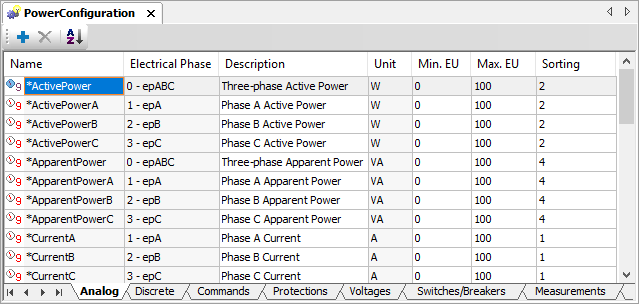The first concept of standardization of Elipse Power concerns the types of Analog Measurements. Measurement types are the different types of existing Measurements in an application, such as Active Power, Line Voltage between Phases A-B, Current in Phase A, Oil Temperature, etc. A Measurement type can concatenate the displayed quantity (for example, "Active Power [W]" or "Temperature [°C]") with the meter location (for example, "Phase A" or "Oil").
By using the concept of Measurement standard, users can reuse the configuration of the quantity unit being sampled (for example, "V", "°C", "W", "Wh", "A", etc.) in the power phase where it is being sampled and in the description of the Measurement (for example, "Active Three-phase Power"). So, when users instance a Measurement in an application (for example, "Voltage in Generator's Terminal"), this Measurement must only point to this standard to retrieve the configurations adopted by the related standard. Thus, if users want to change the description of that Measurement, for example, they only have to perform this in the standard, and all Measurements referring to this standard are automatically updated.
Some standards are provided by Elipse Power installer, and they do not allow changing their names, Electrical Phases, and Engineering Units. These native Elipse Power standards have a reserved prefix "*" and cannot be removed from the list of standards. Some Measurements prefixed with "*" can be used by specific algorithms that are available in Elipse Power (for example, Power Flow, Topological Processor, and State Estimator) or by Elipse Power's Screen objects Library, and therefore they were defined as native. The types of Analog Measurements can be configured at run time in the object returned by the AnalogTypes property of the Power Configuration object. The next figure shows the Analog tab, for creating and editing Analog Measurements standards.

Analog tab
This tab's toolbar contains the options Add ![]() , to create a new type of Analog Measurement, Remove
, to create a new type of Analog Measurement, Remove ![]() , to exclude a user-created Analog Measurement type, and Sort
, to exclude a user-created Analog Measurement type, and Sort ![]() , to sort the visualization of the list of types of Analog Measurements. The columns for each Analog Measurement standard are displayed on the next table.
, to sort the visualization of the list of types of Analog Measurements. The columns for each Analog Measurement standard are displayed on the next table.
Columns for editing Analog Measurement standards
Column |
Description |
|---|---|
Name |
Standard's name. This column can only be edited in user-created standards, and they cannot contain the reserved character "*" as its prefix. Corresponds to the Name property of the Analog Measurement Type object |
Electrical Phase |
Electrical phase where this Measurement is being sampled or this Command is acting. It allows the following values: •-1 - epNone: This Measurement or Command is not related to any phase on the electrical system •0 - epABC: This Measurement or Command relates to three phases on the electrical system •1 - epA: This Measurement or Command relates to phase A on the electrical circuit •2 - epB: This Measurement or Command relates to phase B on the electrical circuit •3 - epC: This Measurement or Command relates to phase C on the electrical circuit •4 - epNeutral: This Measurement or Command relates to the neutral on the electrical circuit •5 - epAB: This Measurement or Command relates to phases A and B on the electrical circuit •6 - epBC: This Measurement or Command relates to phases B and C on the electrical circuit •7 - epCA: This Measurement or Command relates to phases C and A on the electrical circuit •8 - epDevice: This Measurement or Command relates to the same phases that the device is connected to Corresponds to the Phase property of the Analog Measurement Type object |
Description |
Description of this Measurement type. This text can be used to describe a Measurement shown in a Display, to identify an alarm message, or to describe a Pen on a Chart. Users can use expressions on this column. Corresponds to the Caption property of the Analog Measurement Type object |
Unit |
Engineering unit for this Measurement type. Multipliers (that is, Kilo, Mega, Giga, etc.) must not be used, because these multipliers must be configured in the Measurement's instance and not in its standard. Corresponds to the Unit property of the Analog Measurement Type object |
Min. EU |
Minimum value of the engineering unit for this Measurement type. Corresponds to the EuLow property of the Analog Measurement Type object |
Max. EU |
Maximum value of the engineering unit for this Measurement type. Corresponds to the EuHigh property of the Analog Measurement Type object |
Sorting |
An integer that can be used to sort, alternatively to alphabetical order, Measurement types. This is useful for sorting Measurements on a table for a specific presentation order (for example, Voltage before Active Power) that is not alphabetical. This sorting mode is used if PowerExplorer's SortMode property is configured to 1 - smTypeSorting. Corresponds to the Order property of the Analog Measurement Type object |
NOTE |
Standard Measurement types can only have their Description and Sorting columns changed. |